When it comes to famous musicians, Beethoven is likely to hit most top ten charts. Researchers recently peered into his genome to see if they could predict his talent by DNA alone.
Using a previously-identified polygenetic index (PGI) for musical talent, which finds the propensity of certain genes to influence a given trait after a genome-wide association study (GWAS), the researchers were able to compare samples of Beethoven’s DNA to that of two separate population studies with known musical achievement data.
Much to the relief of those who saw Gattaca as a cautionary tale, the scientists found that Beethoven scored only around the tenth percentile for the ability to keep a beat according to his genetic markers. According to the researchers, using genetic markers to predict abilities of an individual can lead to incorrect conclusions, despite their usefulness for group level analyses.
Curious about more musical science? How about reconstructing “Another Brick in The Wall (Part I)” from brainwaves or building a Square Laser Harp?



















